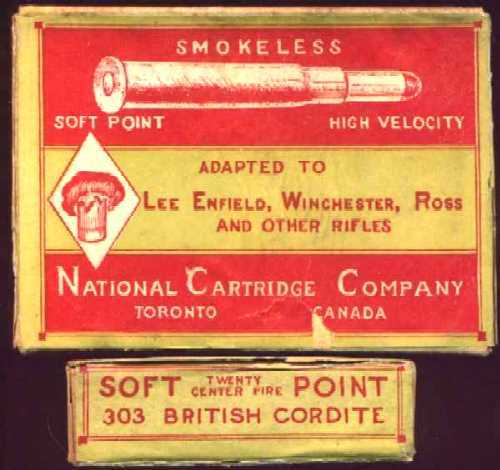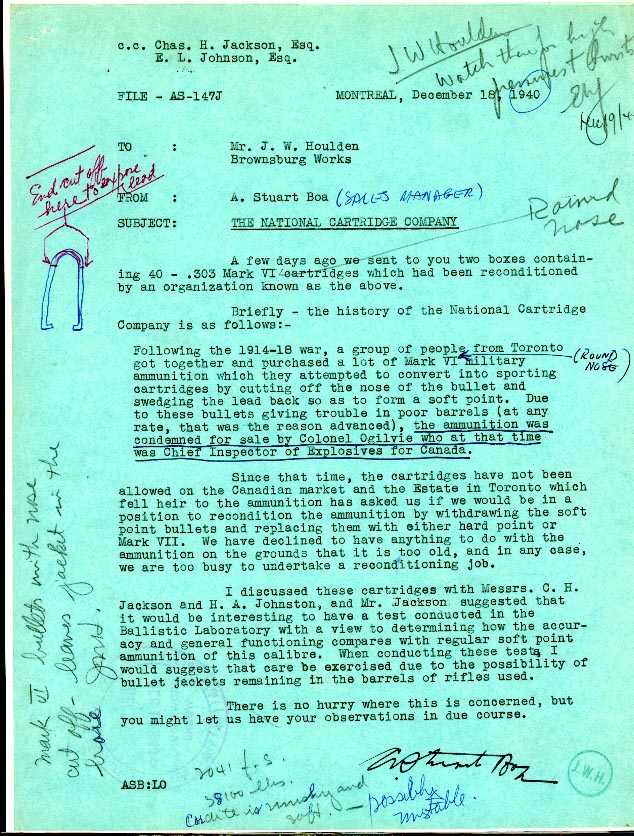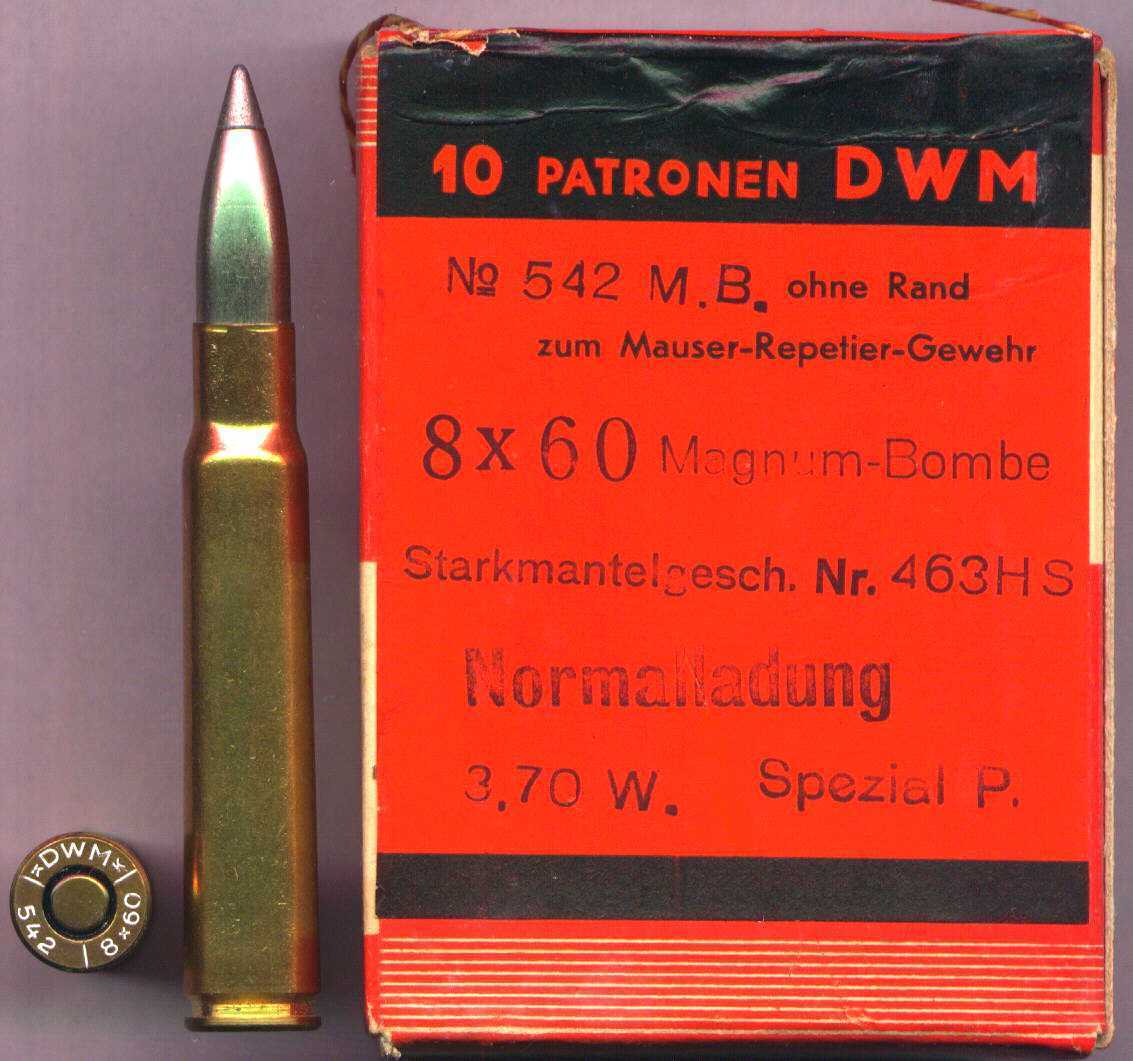|
THE CARTRIDGE COLLECTOR'S EXCHANGE |
| Contents
Cartridge
Lists Links to Other Sites
Organizations:
Auctions:
Books:
Other Collectr's Sites: |
Home of the Old Ammo Guy's Virtual Cartridge
Trading Table
Picture Page
September 2003
A most unusual box of cartridges....
.
This colorful box of .303 British cartridges was recently offered for sale
on an internet auction site. At the time, I knew nothing about the National
Cartridge Company of Toronto, and a quick search through my reference books
yielded nothing. Fortunately, I followed what has proven to be a fairly
dependable sixth sense and made a bid. The box attracted little interest,
received no other bids, and I won it at the sellers relatively low opening
bid amount. While I waited for the box to be shipped to me, I fired off e-mails
to several cartridge collectors (George Hoyem, Brian Clark, and Troy Livingston)
who always seem to come up with answers to my many questions. Within a few
days, I had pretty good picture of the company, as follows: Shortly after
the close of World War 1, a group of entrepreneurs purchased a large quantity
of surplus military .303 British Mark VI ammunition with the intent of modifying
the full metal jacketed bullets to soft points and selling the cartridges
as inexpensive sporting ammunition. The bullet modification involved cutting
through the surface of the jacket near the point to expose the lead core,
then reshaping the exposed core into a blunt, round nose. This was all done
without having to remove the bullets from the cases.
. . . . . . . . . . . . . . . . . . . .
The head stamps from the box above ....
This picture shows the 5 head stamps that are represented among the 20 cartridges in the box of National Cartridge Company .303 British shown above.The first four were made by the Dominion Cartridge Company on contract for the Canadian Government. The fifth one was made at the Dominion Arsenal. The dates of production, from the left, are January, February (more on this one below), July, and December 1907, and March 1910. The 'C' at the 7 o'clock position in the first four head stamps indicates they are loaded with cordite powder, which was composed of nitro-cellulose, nitro-glycerine, and vaseline. Although the fifth cartridge is also a cordite load, its C with the broad arrow inside signifies Canadian government property.
And a most unusual headstamp.....
Here's a closeup shot of the February 1907 headstamp from those shown above. Note the backwards 2. While I had not seen one of these before, I am told that this is the standard headstamp for that month's production. I believe it would be almost impossible for this to have been done unintentionally, as it is so obvious that someone would surely have caught it prior to going into production. Has anyone got the story on this, or even speculation?? Heck, I'm even willing to listen to bald-face lies.
Enough on the National Cartridge Co box....
I had heard about the 8 x 60 Magnum Bombe, but didn't have one in my collection and had never seen a box before, so I was pleased to add this box to my collection and at the same time clear up a couple of misconceptions I had about the cartridge. This box was sealed when I bought it, so there is no doubt that the cartridges are original to the box. When I opened it, I was expecting to find cartridge cases with knurled rims, intended for positive identification of these proof cartridges, and possibly a DWM 542MB case number. As can be seen in the picture, the rim is not knurled, and the case number is 542, standard for the 8 x 60 Mauser cartridge. Closer reading of the limited information I have on the Magnum Bombe indicates that the 'MB' was not included in the head stamp, so the 542 is correct. The box label clearly indicates the cartridges are the Magnum Bombe, so where are my knurls?? These cartridges were made in 1935, as indicated by the small 'k's on either side of the DWM in the headstamp. Is it possible that they were no longer using the knurled rim at that time, but were using some other indicator for identification? Incidentally, the bullet weighs 185 grains. The powder charge is 55 grains of a flake style powder (1 mm square), which fills the case to the mouth and results in a compressed powder charge when the bullet is seated. |


 The result
had the appearance of a factory production soft point. The picture to the
right shows an unaltered Mark VI cartridge below one of the altered cartridges
from the box. Apparently, all of the ammunition was modified without adequately
testing the concept, and it was soon discovered that these cartridges presented
a safety hazard when fired. Since the Mark VI bullet jacket has an open base,
exposing the lead core, the removal of the nose of the jacket allowed pressure
from firing the cartridge to force the lead core out of the jacket, leaving
the jacket behind in the bore of the rifle. Because of this, the ammunition
was condemned by the Canadian government, making its sale in Canada forbidden,
and the company was forced to go out of business. A 1946 internal Dominion
memorandum owned by Jim Houlden, which George Hoyem managed to track down
with the help of John Witzel and Brian Oldfield, reveals a portion of the ‘rest of the
story'. I've included a scan of the memo below, but in a nutshell, an heir to one of the investors in the National Cartridge Company,
who apparently found himself with a large amount of condemned ammunition
to deal with, approached the Dominion Cartridge Company with a sample of
the ammunition and asked if they would be interested in reconditioning it
by removing the defective bullets and replacing them with production sporting
bullets. According to the memo, Dominion decided not to get involved, citing
the age of the ammunition and a lack of production capacity to devote to
the project. Handwritten notes on the edge of the memo indicate that they
did have an interest in shooting the sample ammunition to see how it would
perform. There is also a drawing of a 'sectioned' bullet on the memo which
illustrates the problem with the bullets. At this point, the trail goes cold
regarding this ammunition. If anyone has additional information, I'd appreciate
their contacting me. For anyone interested in seeing the memo, it has been
reproduced in George Hoyem's cartridge collecting column (The IAA on Cartridges)
in the September 2003 issue of The Gun Report.
The result
had the appearance of a factory production soft point. The picture to the
right shows an unaltered Mark VI cartridge below one of the altered cartridges
from the box. Apparently, all of the ammunition was modified without adequately
testing the concept, and it was soon discovered that these cartridges presented
a safety hazard when fired. Since the Mark VI bullet jacket has an open base,
exposing the lead core, the removal of the nose of the jacket allowed pressure
from firing the cartridge to force the lead core out of the jacket, leaving
the jacket behind in the bore of the rifle. Because of this, the ammunition
was condemned by the Canadian government, making its sale in Canada forbidden,
and the company was forced to go out of business. A 1946 internal Dominion
memorandum owned by Jim Houlden, which George Hoyem managed to track down
with the help of John Witzel and Brian Oldfield, reveals a portion of the ‘rest of the
story'. I've included a scan of the memo below, but in a nutshell, an heir to one of the investors in the National Cartridge Company,
who apparently found himself with a large amount of condemned ammunition
to deal with, approached the Dominion Cartridge Company with a sample of
the ammunition and asked if they would be interested in reconditioning it
by removing the defective bullets and replacing them with production sporting
bullets. According to the memo, Dominion decided not to get involved, citing
the age of the ammunition and a lack of production capacity to devote to
the project. Handwritten notes on the edge of the memo indicate that they
did have an interest in shooting the sample ammunition to see how it would
perform. There is also a drawing of a 'sectioned' bullet on the memo which
illustrates the problem with the bullets. At this point, the trail goes cold
regarding this ammunition. If anyone has additional information, I'd appreciate
their contacting me. For anyone interested in seeing the memo, it has been
reproduced in George Hoyem's cartridge collecting column (The IAA on Cartridges)
in the September 2003 issue of The Gun Report.
 .
.

